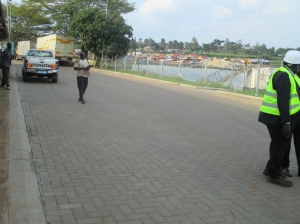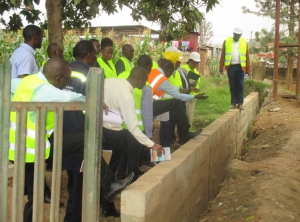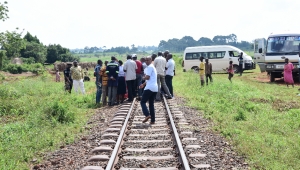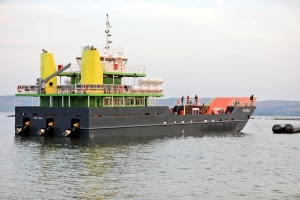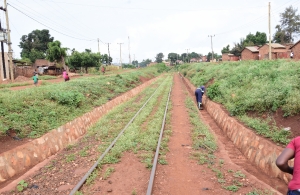Kabindula Swamp Crossing
|
Project Details |
Information |
|
Project name and Length |
Construction of Kabindula Swamp Crossing (180M ) |
|
Contractor |
Ms. Shataman Contractors Uganda Ltd |
|
Contract sum |
Original Contract: UGX 1,245,084,434 |
|
Funder (s) |
Government of Uganda |
|
Districts traversed by project |
Kyankwazi |
|
Commencement date |
18th July 2018 |
|
Completion date |
Initial completion: 30th April 2019 Revised completion : 30th August 2019 |
|
Work done to date (%) against the program |
60% against 71.88% of planned |
|
Supervision Consultant |
Ministry of Works and Transport |
|
Supervision commencement date |
18th July, 2018 |
Project Location
Kabindula Swamp Crossing is located along Ntwetwe – Kitwala Road across River Kitumbi on the District Road Network. The swamp crossing is approximately 180m long, with River Kitumbi marked at the centre.
During inspection, it was observed that the crossing comprised of pipe culverts at these approximate chainages: 5x1200mm diameter concrete culverts at 0+210 and 0+150; 7×1200 mm at 0+180. Most of the culverts were flowing full due to being blocked by silt and also as a result of being laid at very low inverts.
Upon drainage analysis and geotechnical studies, structures were proposed and adopted as the design intervention. It’s upon these findings that the Ministry decided to reconstruct the bridge. A contract agreement was therefore signed on 5th June, 2018 between the Ministry of Works and Transport and M/s. Shataman Contractors (U) Ltd for the construction of Kabindula Swamp crossing in Kyankwanzi District.
Progress
Actual physical works as of July 2019 was at 75% against a planned 100%. Initial project completion date was 30th April 2019, but the project was extended at no cost to 30th August 2019 due to inclement weather which halted works.
Laropi & Obongi Ferry
Project details
Laropi is a marine vessel that connects Adjumani District to Moyo District. It connects the landing sites of Laropi and Umi.
The ferry starts operations at 5:30am and often ends at by 7pm. It has a vessel capacity of 120 tonnes.
It carries an average of 1,500 to 1,800 people per day at the crossing with a minimum of 12 trips and a maximum of 22 trips. It takes 30 minutes for loading and offloading while the time to cross is between 10 to 15 minutes.
The ferry has a capacity of 180 passengers and cargo of 90 tonnes as per the Certificate of Sea Worthiness.
To provide for maintenance of the ferry, usually the team reserves half a day for routine maintenance or conduct one after the end of day route operations.
Project progress
The Laropi Ferry had barely served for a year and was expected to ease the movement of people in Adjumani and Moyo areas.
Staffing and gender issues
The Laropi Ferry has twenty-six (26) staff. These include 10 UNRA staff (1 Ferry Master, 3 Operators, 2 Mechanics, 4 Ferry Attendants), 10 Uganda Police Force staff and 6 support staff. Four (4) of the support staff are females representing 15 % of the total.
Each trip consists of 3 staff that help with the navigation of the ferry and 2 staff for watch keeping.
Observations
The facilities at the landing site at Laropi included 2 waiting sheds, 1 office block and a washroom while the landing site at Umi included 2 waiting sheds and a washroom which was faulty and needed repairs however the locals at the landing site have made it impossible to repair the washrooms due to an ongoing land wrangle. UNRA mentioned that there is an ongoing engagement on the matter.
Access roads to the ferry were in a good condition and there was a clear route schedule visible at both sides of the crossing.
There was a clear demand of the services of the ferry and the Ferry master observed that there had been demands by the passengers for the increase of the ferry operational hours to 10 PM to satisfy the business hours of the local community however this poses a risk to the ferry operators as the ferry is not designed for navigation in the dark.
Safety and security measures
The ferry is insured for passengers and Cargo until 15th August 2020. The ferry has life jackets (235 for adults and 40 for children), 5 ring buoys, 4 sand buckets, a hose, and 8 fire extinguishers (6 onboard and 2 at the operational inputs stores).
There was presence of Aids to navigation in place and they included; ferry lights, an onboard Public Address System, and a reflective signage at Laropi.
There was mandatory passenger registration and screening handled by the Uganda Police, security checks for both passengers, vehicles and luggage before going to the ferry. The Passenger and Cargo manifests were maintained properly.
Kangai Swamp Crossing (Dokolo District)
Project details
The site is 17km from Dokolo Local Government Headquarters and 7km from Kaberamaido town. It borders Kaberamaido and Dokolo Districts linking Kabalega market, Kangai Sub-County and Oyama Sub-County in Kaberamaido District. The Stream empties into the Lake Kyoga Basin.
The Ministry of Works and Transport is undertaking the construction of Kangai Swamp Crossing using Force Account. Works commenced in October 2018 by opening, shaping and gravelling approach roads to allow access to swamp.
The swamp is approximately 400m wide with about 19 lines of culverts which are now and inadequate to accommodate the current hydrological capacity and has led to continuous flooding.
Scope of Works
The scope of work consists of construction of a Cofferdam; Construction of river diversion and culvert installation; Earth works/fills at the abutment and wing walls; River training; Installation of roads furniture; and Quality control management.
Project progress
The approach road works to the swamp from Kangai equivalent to 1 Km were rehabilitated to facilitate easy access of materials to site. Dredging work intended to enlarge the swamp from current 3.5m carriage way to 7.5m and 10m well stabilized rock base fill was done.
Physical Progress
The activities that have been completed include the construction of approach road from Kangai town to the swamp; dredging works along the swamp crossing; Rock base stabilization; and Gravel fills to level the road sections.
On-going activities include assembling of culverts for installation; gravel dumping to increase the vertical and horizontal road sections, and Construction of cofferdam.
The overall works were estimated to cost UGX 700m. Financial progress is 55.2% against a planned progress of 60%.
Rehabilitation of Port Bell warehouses and associated buildings
Uganda Railways contracted Kato Contractors Limited to carry out rehabilitation works for the warehouses and associated buildings at Port Bell Pier at a total cost of UGX. 1.1 bn. The scope of works included:
- Paving the driveway;
- Extension of the hardstand;
- Fencing all-round the premises (800 inner metres);
- Fabrication works, e.g. gates and doors;
- Construction of a 5-stance toilet;
- Construction of two (2) Askari houses;
- Renovation of URA offices.
Progress
The works were completed in May 2019 and the contractor has been paid all the money. One of the major modifications made was the removal of offices from the warehouse, thereby creating more storage space. The offices were relocated to the customs building.
Fencing of the Kampala Goods Shed
Project Location
This project is being carried out within Kampala Railway Station, East of the Railway Headquarter Building.
|
Project Details |
Information |
|
Project Name: |
Contract for Fencing of the Kampala Goods shed |
|
Funding Agency: |
Government of Uganda through MoWT |
|
Contractor: |
M/s. Leading Edge Investments Limited |
|
Client: |
Uganda Railways Corporation. |
|
Contract duration: |
2 months |
|
Original contract sum: |
UGX. 257,580,400 (Excl. Taxes) |
|
Value Added Tax: |
UGX. 46,364,472 |
|
Commencement date: |
4th February, 2019 |
|
Expected completion date: |
26th April, 2019 |
|
Revised completion date: |
22nd November, 2019 |
Purpose of the fence
- To demarcate the Kampala Goods shed and safeguard the URC property and customers’ goods;
- Fencing is a requirement by Uganda Revenue Authority for Customs Bonded Warehouse licensing, yet URC intends to secure customs bonded warehouse operating license.
- To prevent encroachers, trespassers and illegal movement in and out of the Kampala Goods shed.
Scope of works
- Clearing of 3,056m2 of the vegetation and grass along the fence line (2m) on either sides of the fence;
- Excavation and earth works for the foundations;
- Masonry works; building of the concrete block to BS 3921 of 4N/mm2 compressive strength bedded and joint in cement and sand (1:3) mortar 300mm wide and an average height of 750mm with 25mm wide hoop iron every alternate course;
- Precast Concrete; Building the precast copings onto the walls for 764m length of the fence line;
- Palisade fence works and access gates according to the ToR;
- RSA Repair of the 3 access gates: align, stretch and straighten in position “See through gate” made in accordance with the ToR;
- Removal and disposal of waste-site restoration.
Renovation of Kampala Good Shed Warehouse (Phase 1)
The renovation works were done to ensure that the ware houses meet Uganda Revenue Authority minimum requirements for licensing Customs Bonded warehouses. Phase 1 of the contract does not include electrical repairs, telecommunication systems and railway track that enters the warehouse.
|
Project Details |
Information |
|
Project Name: |
Contract for the renovation of the Kampala Goods shed Warehouse Phase I |
|
Funding Agency: |
Government of Uganda through MoWT |
|
Contractor: |
M/s. Joseph Holdings (U) Limited |
|
Client: |
Uganda Railways Corporation. |
|
Contract duration: |
2 months |
|
Original contract sum: |
UGX. 225,410,020 |
|
Revised contract price: |
UGX.60,612,199,680 |
|
Commencement date: |
28th November 2018 |
|
Expected completion date: |
6th February 2019 |
|
Revised completion date: |
13th March 2019 |
Detailed scope of works
The scope of works under this project was limited to internal works including the following:
- Recovery of salvage building materials from the collapsed roof structure. These included roofing sheets, roof timber structures, nails, metallic gutters and roof glazing glasses for safe custody.
- Removing the solid block debris from the collapsed roof which was gutted by fire and disposing it off site.
- Refurbishment of 21 overhead roll up doors- alignment, stretching and straightening in position the overhead rolls up door interlocking galvanized steel slats, structural steel guides and continuous wall angle mountings, double steel angle foot piece with astragal and steel shafts.
- Refurbishment of 3 access gates (G1, G2 and G3)
- Repair of 178m2 floor area of some rooms, and re-screeding of 1016m2 raised floor
- Minor repairs and painting of 3 wooden Cubical warehouse offices scrubbing the wooden surfaces, re-painting the surfaces, replacement of doors with locking system, fixing the sliding windows and window glazing.
- Painting of 3,164m2 warehouse interior walls and 27 flanged columns of 450mm x 450mm. Cleaning the wall surfaces, minor repairs of cracks on the wall, plaster of selected areas of the wall (1:4) mortar and painting of 3890m2 wall surfaces including the partition walls.
- Renovation of roof structure; replacement of defective iron sheets with existing gauge 26 iron sheets recovered from the collapsed roof, straightening and reinforcement of roof trusses by adding more timber members in specific areas, replacement of some rotten roof truss, re-alignment of opening flaps, and diagonal bracing of timber members, welding leakages and sealing of the holes on the iron sheets, overlaps and joints.
- Roof glazing; removal of old wooden roof glazing frames and recovering the roof glazing panes, fabricating 1466m metallic angle section frames for the roof glazing including fixing to the wooden trusses and fixing the 612m2 roof glaze glasses.
- Construction of veranda of 75m2 (in front of the warehouse offices): Demolition of the existing defective veranda, excavating for foundations, packing of hardcore, placing of A142 BRC and 1000 gauge polyethene sheet, and casting 150mm thick veranda concrete.
- Repair of gutters; cleaning of the gutters, welding of the gutters, sealing of the holes and joints, painting of the gutters by spraying
- Fixing of rain water down pipes; fabricating 22 galvanised metallic rain water down pipes including accessories and fittings.
Pre-cast concrete Railway reserve boundary markers phase III
- Project Details
|
Item |
Details |
|
Project Name: |
Supply and Installation of Pre-cast concrete Railway reserve Boundary Markers, Phase III |
|
Contractor: |
Muga Services Limited |
|
Client: |
Uganda Railways Corporation (URC) |
|
Funding: |
GOU Institutional support through MOWT |
|
Works Contract Price: |
UGX.828,280,000 |
|
Start Date: |
15th October 2018 |
|
Contract Period: |
5 months |
|
Intended Completion Date |
15th March 2019 |
|
Time Extension Granted |
3 weeks |
|
Revised Completion Date |
5th April 2019 |
|
Reason for time extension |
Inclement weather, delayed sensitization and boundary opening |
|
Defects liability Period |
6 Weeks |
|
Physical progress |
100% |
|
Financial status |
90% |
Project Overview
Supply and Installation of pre-cast concrete railway reserve boundary markers was identified as a key project in mitigating against the rampant encroachment on URC railway reserve land. The project would play a key role in enforcing, managing and safe guarding the land interests of URC in line with its 5 year strategic plan as one of its strategic objectives.
Phase I had covered the sections of Kampala-Mutundwe, Kampala-Port Bell, Kampala-Mukono-Seeta as well as Jinja and Iganga station approaches. There was resistance in some areas due to land ownership disputes which the contract management team omitted from the project scope. Phase II covered the area gaps identified from Phase I as well as extending the exercise from Mutundwe to Bujuuko, Kawolo-Lubanyi-Nyenga sections.
An in-house reconnaissance survey was previously done in 2018 as well as a pre-commencement sensitization exercise in January 2019. The reconnaissance survey identified the following sections for Phase III; Iganga-Busembatia, Busembatia-Budumba, Budumba-Nagongera, Nagongera-Tororo.
Actual sections covered under the railway reserve boundary markers project Phase III due to the available funding were; Magamaga – Bulanga, Bulanga – Iganga, Iganga – Busembatia, Busembatia – Budumba and Budumba – Nagongera.
The project is fully funded by Government of Uganda under the institutional support program through the Ministry of Works and Transport.
Scope of works
- Supply of reinforced concrete railway reserve boundary markers Type A and B including delivery to erection sites
- Testing and quality control of boundary markers as prescribed in the statement of requirements
- Clearing of vegetation at the boundary marker erection sites
- Opening boundaries of railway reserves including provision of survey report duly signed by a registered land surveyor
- Erecting reinforced concrete boundary markers Type A and B
- Painting of erected boundary markers as prescribed in the statement of requirements
- Geo-referencing of erected boundary markers including submission of a survey report.
MV Sigulu
Project details
Sigulu Ferry is in the advanced stages of construction to serve Namayingo district by connecting the Namayingo mainland to Sigulu Island and Lolwe Island on Lake Victoria. The landing sites where the ferry will dock are being developed accordingly. This ferry will provide a safe means for the communities to travel at costs met by the Government. Overall, the project will positively impact the communities through increased volumes of trade, tourism, increased access to social services especially those, which are lacking or inadequate in the islands.
Project progress
The project cost is US 4.3 million and the contractor M/S Johs. Gram-Hanssen AlS (JGH) - Western Marine Shipyard Limited Joint Venture has implemented the project up to 98% completion. The key features of this ferry are the hull, propulsion systems, wheelhouse, sheltered passenger seating areas, crew rest room, medical room and cafeteria.
The contractor has finalized most of the painting works, installation of electrical, propulsion and navigation equipment. The Ferry was floated on water, end of June 2019 and the two-week familiarization training immediately commenced. During the training, testing and sea trials were also conducted. Ministry of works and Transport carried out a seaworthiness inspection of the ferry on 25th July 2019. The ferry capacity is 300 passengers and it is currently the biggest Ugandan passenger inland vessel.
Rehabilitation and drainage improvement of the railway line at Magamaga and Budumbuli
Project Details
|
Item |
Information |
|
Project Name: |
Rehabilitation and drainage Improvement of the Railway line at Magamaga and Budumbuli |
|
Contractor: |
Kato Contractors Limited |
|
Client: |
Uganda Railways Corporation (URC) |
|
Funding: |
GOU Institutional support through MOWT |
|
Works Contract Price: |
481,415,220 UGX |
|
Start Date: |
8th November 2018 |
|
Contract Period: |
2 Months |
|
Intended Completion Date |
7th February 2019 |
|
Time Extension Granted |
12 Days |
|
Reason for time extension |
Variation Order |
|
Further Extension approved |
28 days |
|
Reason for further time extension |
Inclement weather, provision of LSBs & Engineering train |
|
Revised Completion Date |
20th March 2019 |
|
Defects liability Period |
6 Weeks |
|
Physical progress |
100% |
|
Financial status |
90% |
Project Overview
Rehabilitation and drainage improvement of the railway line at Magamaga and Budumbuli was identified as a key project in improving the track availability which was affected by the speed restrictions and the occasional line blocks at these locations. Both these locations are within cut sections stretching from Mileage 312/4 to 312/8 at Magamaga, and Mileage 322/2 to 322/6 at Budumbuli.
Due to the proximity of human activity to the railway track especially at Budumbuli, catch water drains were blocked by waste resulting into surface runoff and attendant sedimentation being directed onto the railway track. Additionally, boulders on the steep back slopes became unstuck and were released onto the railway track during heavy rains. All this led to line blocks in order to clear the track of the debris or temporary speed restrictions (TSRs).
At Magamaga, all the surface run-off from the surrounding hills was directed onto the railway track due to inadequate and blocked catch water drains. This coupled with the shallow and blocked side drains within the cut section, led to water ponding on the railway track that caused train failures (wheel slip) and line blocks. Eventually, this water ponding led to an unstable track and speed restrictions due to a weak formation.
As such, this project was identified to rehabilitate the railway line through re-ballasting at these sections with contaminated or no ballast and poor track joints as well as improving the drainage at these locations through stone pitching of the side drains, opening the catch water drains and culvert construction.
Due to a limited available budget, a variation order was issued to extend the coverage of the drainage improvement (stone pitching) in lieu of the re-ballasting. The project would play a key role in improving track availability in line with its 5 year strategic plan as one of its strategic objectives.
Scope of works
- Weeding and bush clearing
- Ballasting
- Drainage improvement works; stone pitching works for side drains and opening catch water drains
- Culvert construction; Access and railway cross culverts
- Gabion construction
- Earth works; Shaping back slopes
Rehabilitation of Kyenjojo - Fort Portal Road (50km)
|
Project Details |
Information |
|
Project name and Length |
Civil works for the Rehabilitation of Kyenjojo – Fort Portal Road (50km) |
|
Contractor |
M/s China Wu Yi Co. Ltd |
|
Contract sum |
UGX 71,435,766,901 (including VAT) |
|
Funder (s) |
GOU |
|
Districts traversed by project |
Fort Portal and Kyenjojo |
|
Commencement date |
29th June 2016 |
|
Completion date |
Original: 28th December 2017 Revised: 31st August 2019 |
|
Supervision Consultant |
M/s. MBW Consulting Ltd 29th June 2016 to 31st January 2018; then UNRA Team from 1st February to project end |
|
Supervision commencement date |
5th April,2016 |
|
Contract Price |
48,412,573,498 (including cash) |
|
Commencement date |
24th May 2019 |
|
Completion date |
23rd February 2020 |
Project details
The Government of Uganda, through Uganda National Roads Authority (UNRA) procured a Contractor, MIS China Wu Yi Co. Ltd Uganda, to undertake Civil Works for Rehabilitation of Kyenjojo - Fort Portal (50km) road. A Works Contract was awarded on 2nd December 2015, signed on 30th December 2015 and commenced on 29th June 2016 with the original completion of 28th December 2017. Amendments were proposed to the contract and, in the circumstances, extensions of time were inevitable due to time for effecting the change order (and other contractual challenges).
The Amendments to the works contract were due to, change in the ridding surface from DBST to AC20, substantial increases in relocations and earthworks and provision for rock fill (particularly under swamp culverts and in widened swamp areas) which could not be accommodated by site instructions. There was substantial increase in cost of about 60%. The length for the AC was therefore limited to 10km. Another procurement for completion of the road with the desired surfacing of AC was initiated to cover the section from km 10 up to km 50.
The Rehabilitation works for Kyenjojo - Fort Portal road (50km) are implemented under two separate Contracts by one Contractor that one for the Road Rehabilitation where by the section to be surfaced is 10k and the second of Supply and lay AC and Tack coat which covers the rest of the length.
The changes above led to extensions of time up to 31 August 2019 for the road rehabilitation contract but the Supply and lay AC and Tack coat contract ends on 23rd February 2020
Both of these contracts are under one Construction Supervision Team. This brief, therefore covers works under the rehabilitation contract and the Supply and lay AC and Tack coat ends contract.
The Supervision of the Works was initially done by a Consultant, Ms MBW Consulting Ltd/infrastructure Projects Ltd JV. The consultancy contract ended on 31 January 2018. Since pt February 2018, the supervision of works is done by the UNRA Construction Supervision Team (CST)
Progress
The aggregated (for both contracts) physical progress is 96% against the planned 98.5%. The contract time elapsed is 1156 days which is 99.3% of the time for the rehabilitation contract but only 91days which are 33% of the time for the supply and lay of tack coat and AC contract.

